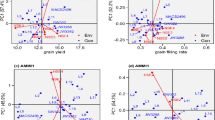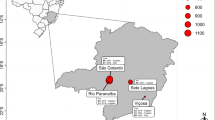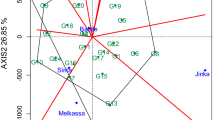Abstract
Climate variability and associated droughts are major environmental factors limiting crop productivity worldwide. Identification and better understanding of factors influencing genotype × environment (GE) interaction in drought-prone environments will allow breeders and producers to improve crop productivity. The objectives of this study were to identify genotypic and climatic factors responsible for GE interactions in durum wheat yield trials under highland cold and moderate cold rainfed areas of Iran. Field experiments were carried out using 20 durum wheat genotypes, differing in growth habit, in three highland rainfed research stations for three cropping seasons (2015–2018). Environments were characterized by climatic co-variables measured during the three seasons. Genotypes were described by co-variables related to phenology, agronomy and disease resistance. Possible factors influencing GE interaction were examined by factorial regression (FR), partial least squares (PLS) regression and the additive main effects and multiplicative interaction (AMMI) models. The results indicated that both AMMI IPCA1 and IPCA2 scores had positive and negative values, resulting in crossover GE interaction and leading to inconsistent yield performance of genotypes across environments. The AMMI, PLS and FR identified similar genotypic and climatic variables that explained a large proportion of the GE interaction for grain yield. Based on the results, the climatic variables of average temperature, rainfall, relative humidity, minimum and maximum temperature, and genotypic variables of heading date, plant height and 1000-kernel weight were among the most important factors responsible for differential genotype adaptation. The PLS biplot showed that the genotypic responses to environmental covariates depended strongly on the growth habit type. This information can contribute toward the identification and biological understanding of adaptive characteristics relevant for durum wheat breeding in highland cold rainfed conditions of Iran and facilitate cultivar recommendation at eco-regional level. In conclusion, the AMMI, PLS and FR complement each other and the PLS biplot offered further interpretations of the GE interaction including differential genotype adaptation.

Similar content being viewed by others
References
Aastveit H, Martens H (1986) ANOVA interactions interpreted by partial least squares regression. Biometrics 42:829–844
Abdalla OS, Crossa J, Autrique E, DeLacy IH (1996) Relationships among international testing sites of spring durum wheat. Crop Sci 36:33–40
Akaike H (1974) A new look at the statistical model identification. IEEE Trans Auto Control 19:716–723
Basford KE, Cooper M (1998) Genotype × environment interactions and some considerations of their implications for wheat breeding in Australia. Aust J Agric Res 49:153–174
Battisti DS, Naylor RL (2009) Historical warnings of future food insecurity with unprecedented seasonal heat. Science 323:240–244
Brancourt-Hulmel M, Lecomte C (2003) Effect of environmental variates on genotype × environment interaction of winter wheat. Crop Sci 43:608–617
Campbell BT, Baenziger PS, Eskridge KM, Budak H, Streck NA, Weiss A, Gill KS, Erayman M (2004) Using environmental covariates to explain genotype × environment and QTL × environment interactions for agronomic traits in chromosome 3A of wheat. Crop Sci 44:620–627
De Vita P, Mastrangelo AM, Matteu L, Mazzucotelli E, Virzi N, Palumbo M, Lo Storto M, Rizza F, Cattivelli L (2010) Genetic improvement effects on yield stability in durum wheat genotypes grown in Italy. Field Crop Res 119:68–77
Denis JB (1988) Two-way analysis using covariates. Statistics 19:123–132
Gauch HG (1988) Model selection and validation for yield trials with interaction. Biometrics 44:705–715
Joshi AK, Crossa J, Arun B, Chand R, Trethowan R, Vargasf M, Ortiz-Monasterio I (2010) Genotype × environment interaction for zinc and iron concentration of wheat grain in eastern Gangetic plains of India. Field Crop Res 116:268–277
Kendal E, Sener O (2015) Examination of genotype × environment interactions by GGE biplot analysis in spring durum wheat. Indian J Genet Plant Breed 75:341–348
Malvar RA, Revilla P, Butron A, Gouesnard B, Boyat A, Soengas P, Alvarez A, Ordas A (2005) Performance of crosses among French and Spanish maize populations across environments. Crop Sci 45:1052–1057
Mohammadi R (2016) Efficiency of yield-based drought tolerance indices to identify tolerant genotypes in durum wheat. Euphytica 211:71–89
Mohammadi R, Farshadfar E, Amri A (2015) Interpreting genotype × environment interactions for grain yield of rainfed durum wheat in Iran. Crop J 3:526–535
Mohammadi R, Armion M, Zadhasan E, Ahmadi MM, Amri A (2018) The use of AMMI model for interpreting genotype × environment interaction in durum wheat. Exp Agric 54:670–683
Mohammadi R, Etminan A, Shooshtari L (2019) Agro-physiological characterization of durum wheat genotypes under drought conditions. Exp Agric 55:484–499
Motzo R, Giunta F, Deidda M (2001) Factors affecting the genotype × environment interaction in spring triticale grown in a Mediterranean environment. Euphytica 121:317–324
Pacheco A, Vargas M, Alvarado G, Rodríguez F, Crossa J, Burgueño J (2016) GEA-R (genotype × environment analysis with R for Windows). Version 2.0. CIMMYT. http://hdl.handle.net/11529/10203. Accessed 20 June 2016
Peterson RF, Campbell AB, Hannah AE (1948) A diagrammatic scale for estimating rust intensity on leaves and stems of cereals. Can J Res 26:496–500
R Core Team (2016) R: a language and environment for statistical computing. R Foundation for Statistical Computing, Vienna
Reynolds MP, Acevedo E, Sayre KD, Fischer RA (1994) Yield potential in modern wheat varieties: its association with a less competitive ideotype. Field Crop Res 37:149–160
Reynolds MP, Trethowan R, Crossa J, Vargas M, Sayre KD (2004) Erratum to “Physiological factors associated with genotype by environment interaction in wheat”. Field Crop Res 85:253–274
Richards RA (1982) Breeding and selection for drought resistant wheat. Drought Resistance in Crops with Emphasis on Rice. International Rice Research Institute, Manila, pp 133–150
Roelfs AP, Singh RP, Saari EE (1992) Rust diseases of wheat: concepts and methods of disease management, 2nd edn. CIMMYT, Mexico, D.F.
Romay CM, Malvar RA, Ramirez LC, Alvarez A, Moreno-Gonzalez J, Ordas A, Revilla P (2010) Climatic and genotypic effects for grain yield in maize under stress conditions. Crop Sci 50:51–58
Rozeboom KL, Schapaugh WT, Tuinstra MR, Vanderlip RL, Miliken GA (2008) Testing wheat in variable environments: genotype, environment, interaction effects, and grouping test locations. Crop Sci 48:317–330
Schneider SH (1989) The changing climate. Sci Am 261:70–79
Stojaković M, Mitrović B, Zorić M, Ivanović M, Stanisavljević D, Nastasić A, Dodig D (2015) Grouping pattern of maize test locations and its impact on hybrid zoning. Euphytica 204:419–431
van Eeuwijk FA, Denis JB, Kang MS (1996) Incorporating additional information on genotypes and environments in models for two-way genotype by environment tables. In: Kang MS, Gauch HG (eds) Genotype-by-environment interaction. CRC Press, Boca Raton, FL, pp 15–49
Vargas M, Crossa J, Sayre K, Reynolds M, Ramirez M, Talbot M (1998) Interpreting genotype × environment interaction in wheat by partial least squares regression. Crop Sci 38:679–689
Vargas M, Crossa J, van Eeuwijk FA, Ramirez ME, Sayre K (1999) Using partial least squares, factorial regression and AMMI models for interpreting genotype × environment interaction. Crop Sci 39:955–967
Vargas M, Crossa J, van Eeuwijk FA, Sayre K, Reynolds MP (2001) Interpreting treatment × environment interaction in agronomy trials. Agron J 93:949–960
Acknowledgements
The first author thanks the reviewers and the editor of journal of Cereal Research Communications for providing helpful comments and corrections on earlier drafts of this manuscript.
Funding
Funding was provided by Dryland Agricultural Research Institute (Grant No. 0-15-15-94165).
Author information
Authors and Affiliations
Corresponding author
Additional information
Communicated by H. Grausgruber.
Electronic supplementary material
Below is the link to the electronic supplementary material.
Rights and permissions
About this article
Cite this article
Mohammadi, R., Sadeghzadeh, B., Ahmadi, M.M. et al. Biological interpretation of genotype × environment interaction in rainfed durum wheat. CEREAL RESEARCH COMMUNICATIONS 48, 547–554 (2020). https://doi.org/10.1007/s42976-020-00056-7
Received:
Accepted:
Published:
Issue Date:
DOI: https://doi.org/10.1007/s42976-020-00056-7




